What makes the Filipino spirit so strong despite many challenges? Poverty affects about 16.6% of the population, and unemployment is around 5.4% as of October 2022. These issues lead to more mental health problems. The answer is Pag-asa, a symbol of hope and resilience in Filipino culture. It’s vital to grasp the importance of Pag-asa in boosting hope and resilience.
The Philippines faces many challenges, like the damage from six powerful typhoons in 2024. These disasters caused over a hundred deaths and billions of pesos in damage. Yet, about 90% of Filipinos start the New Year with hope, a Social Weather Stations (SWS) survey shows. This proves that hope and resilience are key to the Filipino spirit.
Key Takeaways
- Filipinos are known for their resilience, which is deeply rooted in their ability to find hope and patience in adversity.
- Pag-asa is a symbol of hope and resilience that is central to Filipino culture.
- Approximately 1 in 5 Filipinos experience mental health issues at some point in their lives, highlighting the need for hope and resilience.
- The Philippines has a severe shortage of mental health professionals, with only 0.29 psychiatrists per 100,000 individuals.
- Community health workers can improve mental health outcomes significantly, with a possible 70% increase in treatment seeking when community support programs are implemented.
- The concept of Pag-asa is essential in promoting hope and resilience in the face of adversity.
Understanding the Concept of Pag-asa
Pag-asa is a Filipino concept that means hope and resilience. It’s a way of life that helps Filipinos stay optimistic when facing challenges. The values of pakikipagkapwa and bayanihan, which focus on community and solidarity, are at the heart of Pag-asa.
A study on cultural values that shape resilience shows Pag-asa is more than a concept. It’s a way of life shaped by the Philippines’ history and experiences. Filipinos look to the future with hope, inspired by Pag-asa’s principles.
Definition and Cultural Significance
Pag-asa is the hope and resilience Filipinos show when facing hard times. It’s a cultural value deeply rooted in the Filipino spirit. With optimism and a strong sense of community, Filipinos can overcome big challenges and build a better future.
Historical Context of Pag-asa in Filipino Society
The history of Pag-asa in Filipino society is complex. It’s influenced by colonization, poverty, and natural disasters. These experiences have made Filipinos resilient and hopeful. As they face and overcome challenges, they are guided by Pag-asa’s principles towards a brighter future.
The Role of Hope in Filipino Culture
Faith and spirituality give people a sense of purpose and help them move forward when things get tough. In the Philippines, hope is a big part of the culture. It helps people stay positive even when times are hard. Religion plays a big role in this, bringing comfort and reassurance.
The community is also key in keeping hope alive. In the Philippines, “bayanihan” or communal unity is a big deal. People come together to help each other out. This community support helps people deal with challenges and stay hopeful.

- Religious beliefs and practices
- Community support and togetherness
- Cultural values like resilience and resourcefulness
Together, these factors make Filipinos strong in hope and resilience. They face challenges with courage and determination.
Resilience Defined: The Filipino Way
Resilience is a big part of Filipino culture. It’s not just about getting through tough times. It’s about coming out stronger and more determined. This way of dealing with challenges combines patience, flexibility, and a strong community spirit.
Events like natural disasters and economic troubles have shaped how Filipinos see resilience. For example, the Philippines often faces tropical cyclones and floods, like in Region I. The “Handa Pilipinas” campaign works to improve disaster preparedness and resilience among everyone.
Personal Stories of Overcoming Challenges
Stories of Filipinos facing and beating challenges show the country’s optimism. The “Handa Pilipinas: Innovations in Disaster Resilience” event highlights local tech for disaster readiness. It shows how important resilience is when facing natural disasters.
Some key ways to build resilience include:
- Strengthening building structures
- Relocating to safer areas
- Ensuring usability before and after disasters
By using these strategies and promoting a culture of optimism and resilience, Filipinos can handle challenges better. They can come out stronger and more determined.
| Disaster | Year | Impact |
|---|---|---|
| Tropical cyclones | 2020 | Widespread flooding and damage |
| Floods | 2019 | Displacement of thousands of people |
Education as a Catalyst for Change
Education is key in bringing hope and strength to people and communities. It gives them the knowledge and skills to create a brighter future. In the Philippines, many efforts are underway to boost education and help kids and teens grow.
The USLS-Bahay Pag-asa Youth Center is one such effort. It aims to give quality education and support to kids in trouble and at risk. The center offers educational resources, life skills training, and spiritual guidance. Its goal is to help these young ones become independent, productive, and responsible citizens.
Some of the center’s main programs and services include:
- Education and literacy programs
- Life skills training and counseling
- Spiritual formation and values education
- Recreational and cultural activities
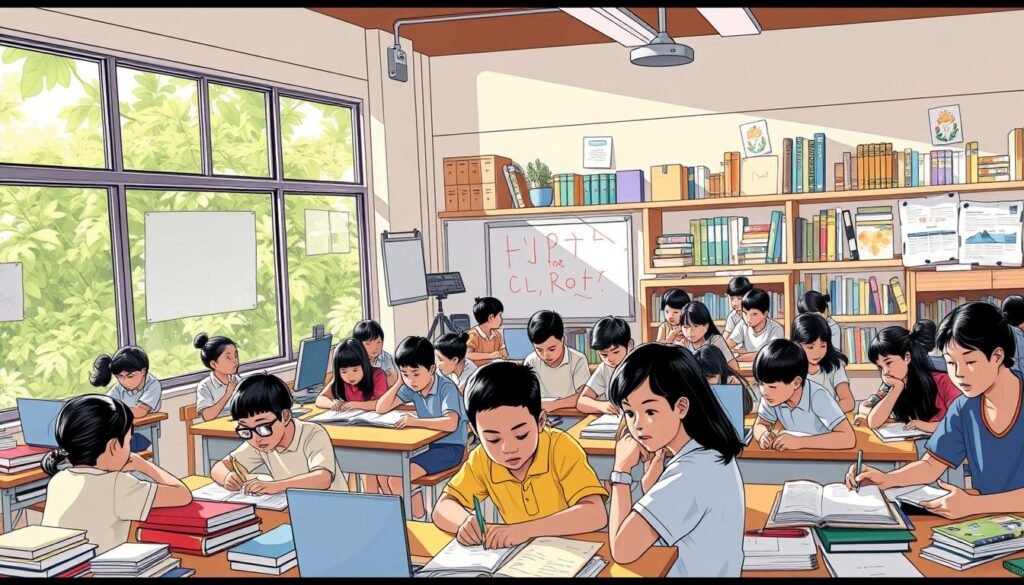
These efforts show how vital education is in spreading hope and resilience. By giving quality education and support, we can help people build a better future for themselves and their communities.
| Program | Objective | Target Group |
|---|---|---|
| USLS-Bahay Pag-asa Youth Center | Provide quality education and support to CICL and CAR | Children and youth aged 9-18 |
| Education and literacy programs | Improve literacy rates and educational outcomes | Children and youth |
| Life skills training and counseling | Develop life skills and provide counseling support | Children and youth |
Art and Literature: Expressions of Pag-asa
Philippine art and literature show the country’s vibrant hope and resilience. This year’s National Arts Month theme, “Sining ng Pag-asa,” emphasizes art’s role in showing hope. Artists like Elly Cua and Lucille Garibay inspire with their works, spreading optimism and community.
Some key events and initiatives for art and literature include:
- National Arts Month, celebrated every February, with performances, exhibits, and workshops
- The National Committee on Literary Arts’ two-day conference, on March 25 and 26, 2022
- The “Bagong Biswal 2022” program, featuring 30-40 artists or artist groups in five installments

The National Commission for Culture and the Arts (NCCA) supports art and literature. They aim to build a sense of community and optimism across the country. By celebrating diverse expressions of Pag-asa, Filipinos unite to inspire hope and resilience.
Government Initiatives Promoting Resilience
The government is key in boosting resilience through policies and programs. In the Philippines, many efforts aim to fight natural hazards and climate change.
The GeoRisk Philippines Initiative is a big step. It wants to be the main source for hazard and risk info. It moves from just weather forecasts to a full system for early warnings.
Key Policies Supporting Community Development
The Department of Science and Technology (DOST) has set eight Key Result Areas. These areas match the Sendai Framework for Disaster Risk Reduction (SFDRR) priorities.
- Strong policies for disaster risk reduction are backed by solid science.
- The CORE Capacity Building Training Program has five ways to boost local climate plans.
- A joint memo by the Climate Change Commission (CCC) and the Department of the Interior and Local Government (DILG) helps with local climate action plans.
Success Stories from Government Programs
The SHIELD Programme, backed by the Australian Government, aims to make the Philippines more resilient. It’s working in 11 provinces, helping with climate and disaster efforts.
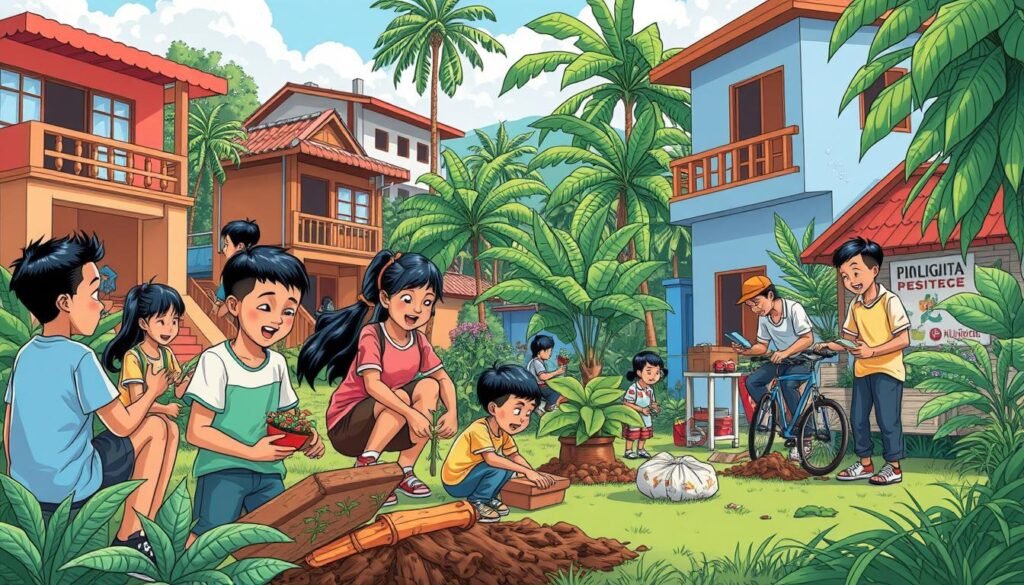
| Program | Description |
|---|---|
| GeoRisk Philippines Initiative | Central source of information for hazards and risk assessment |
| CORE Capacity Building Training Program | Enhances local climate change action plans |
| SHIELD Programme | Enhances resilience to climate change and natural hazards |
These efforts help build stronger, more resilient communities. They ensure a brighter future for the Philippines. By focusing on resilience, the government is working towards a more sustainable, disaster-ready nation.
Non-Governmental Organizations (NGOs) in Action
Non-Governmental Organizations (NGOs) are key in bringing hope and support to communities in need. In the Philippines, groups like NPO-ACTION have been vital. They organize work camps and help families and children hit by disasters and conflicts.
NPO-ACTION started in 1994 after the Mt. Pinatubo eruption in Zambales. They focus on work camps in various places in Zambales. This gives hope and support to those who need it most. Some of their big wins include:
- Building water systems for Aeta communities
- Renovating homes for children with disabilities
- Starting the CHIKARA program for kids’ development
These actions show how much NGOs can do for hope and community growth. Working with local governments and others, NGOs can fill important gaps. They offer a helping hand to communities in need.
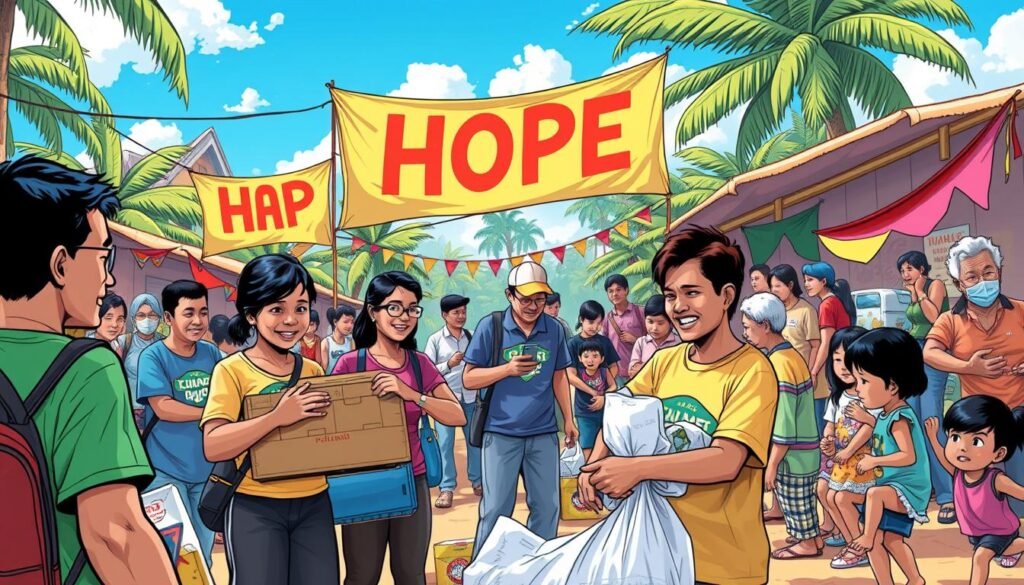
Thanks to their hard work, NGOs like NPO-ACTION are making communities stronger. They’re also bringing hope to those they help.
| NGO | Year Established | Notable Achievements |
|---|---|---|
| NPO-ACTION | 1994 | Constructing water systems, renovating residential facilities, launching the CHIKARA program |
The Impact of Natural Disasters on Filipino Resilience
The Philippines is hit hard by natural disasters, like typhoons and earthquakes. The people’s optimism and resilience show their strength in these tough times.
Typhoon Rai in December 2021 and Tropical Storm Sendong in 2011 are examples. These disasters pushed for better early warning systems and resilience efforts.
Here are some key facts about natural disasters in the Philippines:
- The country is ranked first in the World Risk Report 2023.
- About 21 cyclonic storms hit the Philippines each year.
- Natural disasters cause around 206 billion Philippine Pesos in losses annually.
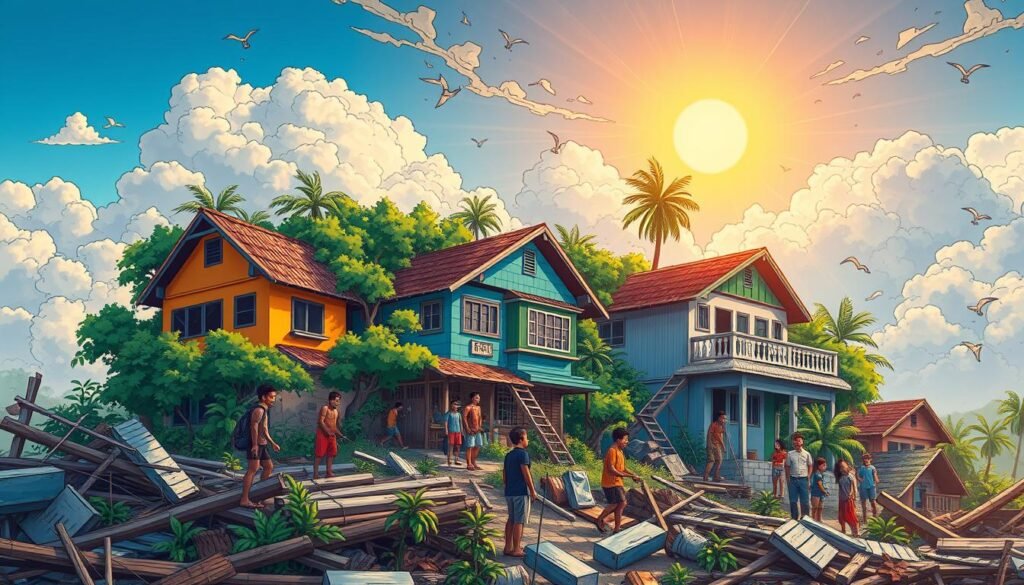
Despite the odds, Filipinos remain resilient and optimistic. The government, NGOs, and private sector are working together. They aim to improve early warnings, help those in need, and support recovery.
| Disaster | Year | Impact |
|---|---|---|
| Typhoon Rai | 2021 | Second deadliest disaster worldwide |
| Tropical Storm Sendong | 2011 | Over 1,000 fatalities and 700,000 affected individuals |
Financial Security and Its Link to Hope
Financial security is key to hope and resilience. It gives a sense of stability and security. The National Strategy for Financial Inclusion (NSFI) says financial services can greatly improve lives, mainly for the poor and marginalized.
This strategy aligns with the Philippine Development Plan (PDP). It aims to create a financial system that serves everyone’s needs. This is important for a stable and secure future.
Research shows that more financial inclusion leads to better economic stability. It also helps reduce income gaps and poverty. The Philippine government’s efforts to include more people in the economy are promising. The country’s 5.7 percent economic growth in 2021 shows its strong economic future.

Initiatives like microfinancing programs help a lot. They give financial services to those who need them most. These programs have been successful in reducing poverty and boosting the economy.
As the Philippine economy keeps growing, it’s vital that everyone benefits. This way, everyone can have hope for a better future.
The Role of Social Media in Spreading Hope
Social media is a strong tool for spreading hope and building resilience, mainly among the young. With about 4.76 billion people using it, it reaches a huge audience. Research on hope shows it’s great for sharing positive messages and building support networks.
The community side of social media is key. It lets people connect with others who have similar experiences. This feeling of optimism and belonging fights off loneliness and despair. By sharing stories, users can inspire and support each other, spreading hope and resilience.
Here are some examples of social media campaigns that inspire resilience:
- Hashtag challenges that promote positive messages and actions
- Online support groups for people affected by natural disasters or other crises
- Influencer partnerships that raise awareness and funds for social causes
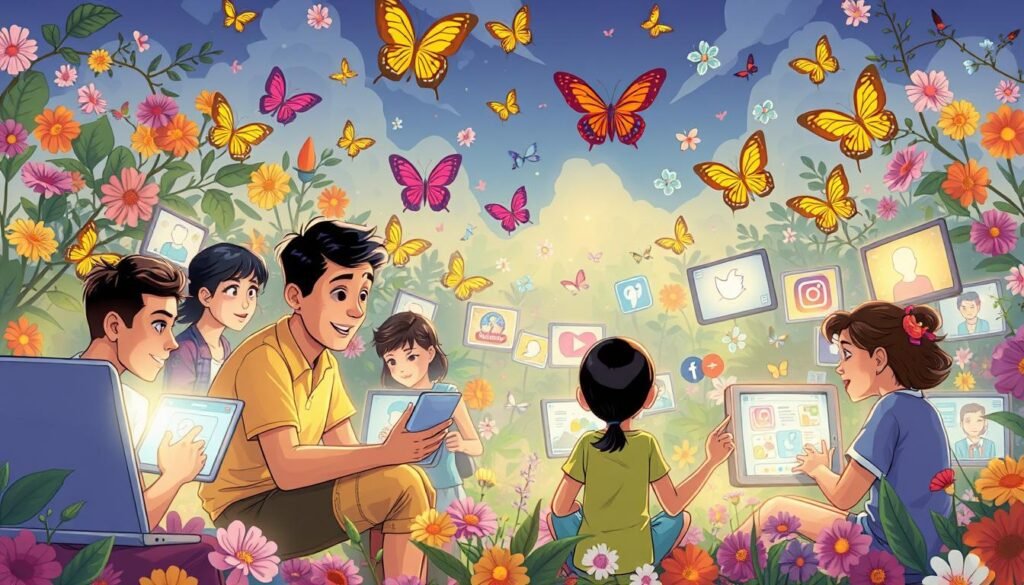
By using social media wisely, we can build a more supportive and optimistic community. Here, people can share hope and resilience together.
Youth Engagement and the Future of Pag-asa
Getting young people involved is key to a better future. They are the next leaders and innovators. The future of the Philippines relies on empowering its youth. This means investing in their education and growth.
The Binhi ng Pag-asa Program (BPP) 2024 is a great example. It aims to train 1,063 young farmers. They will learn about sustainable farming and how to use social media.
This program is a partnership between Senator Grace Poe’s office and the Department of Agriculture. It’s all about giving young people the chance to grow. This way, we can build a culture of hope and strength.
As the Philippines faces new challenges, it’s vital to focus on youth education. We must make sure they are ready for the future.
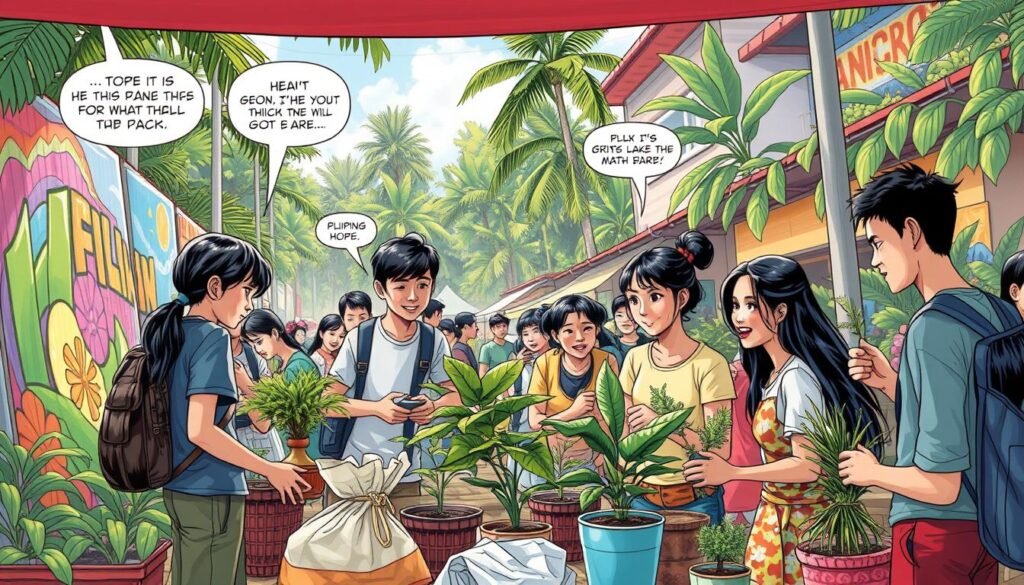
- 1.1 million learners didn’t sign up for school in 2020-2021, says the Department of Education.
- The Convention on the Rights of the Child (CRC) talks about four main rights for kids: survival, development, protection, and participation.
- The National Summit on Child Rights in Education (NSCREd) will happen on November 14-15, 2019. It’s the first of its kind in the Philippines.
By investing in young people’s education, the Philippines can look forward to a brighter future. It’s important to focus on their needs and give them the tools to succeed.
Celebrating Filipino Festivals as a Source of Hope
Filipino festivals show off the country’s vibrant culture and community spirit. They bring people together, spreading optimism and hope. This unity and shared identity are key.
The San Roque Festival is a great example. It has been celebrated for over 261 years. It includes traditional dances, music, and a special mass. This highlights the community’s faith and cultural traditions.
At the festival, people also make and sell sweet treats. This helps the local economy and gets everyone involved. Local leaders and residents from different areas show how important the festival is. It brings optimism and unity to the community.

These festivals are key in keeping hope alive. They reflect the Filipino community’s values and add to the country’s cultural richness. By celebrating, Filipinos can share their stories and inspire optimism in each other.
The Influence of Sports on Community Hope
Sports can inspire and unite communities, bringing hope and resilience. In the Philippines, sports tackle many issues. They promote health and well-being among those who take part.
Sports have a big impact on community hope. They bring people together, creating a sense of shared purpose. For example, surfing has helped Siargao Island’s economy grow. Many locals now benefit from tourism and sports.
Filipino Athletes Who Inspire Resilience
Filipino athletes have greatly inspired hope and resilience. Their achievements and hard work motivate others to aim high and face challenges head-on.
Community Sports Programs Encouraging Hope
Community sports programs are key in boosting hope and resilience among the young. They offer chances for youth to improve their skills, gain confidence, and become active community members.
- Approximately 1.2 billion young people aged 15 to 24 globally, representing 16 percent of the global population, can benefit from sports initiatives.
- In the Philippines, there are around 19.2 million youth aged 15 to 24, most of whom are either in schools or engaged in the workforce, and can be reached through community sports programs.
- Over 20 years of community service, Pag-asa Social Center has assisted approximately 620 families through community projects, amounting to an estimated P160 million in resources, demonstrating the impact of sports on community hope.

Pag-asa in the Era of Global Challenges
The world faces many challenges, but the Filipino Pag-asa offers hope. The Philippines has shown strength in the face of disasters and tough times. It’s ready to lead in creating a future full of resilience and hope.
The Philippines is investing in its Coast Guard and defense. This shows the government’s dedication to protecting its people and land. The Amended Public Service Act (RA has also brought in foreign investments. This has led to new technologies and economic growth, helping communities and the nation’s resilience.
The Philippines is also tackling environmental issues. Communities have shown they can adapt and succeed. Stories of people like Pascual inspire the next generation. They show the Filipino spirit that has overcome hard times.
The future of Pag-asa in the Philippines depends on its people. They have always found a way to overcome challenges. As the country faces new complexities, the spirit of resilience will lead it to a better tomorrow.
FAQ
What is the concept of Pag-asa and its cultural significance in the Philippines?
Pag-asa is a Filipino concept that means hope, resilience, and optimism. It’s a big part of Filipino culture. It helps Filipinos face challenges and look forward to the future.
How does the role of religion and community support contribute to the Filipino’s sense of hope and resilience?
Religion and community ties are key for Filipinos to stay hopeful and resilient. They help Filipinos deal with hard times and come out stronger.
What are the unique aspects of the Filipino approach to resilience, and how have historical events shaped this?
Filipinos are patient, flexible, and community-focused. Historical events, like natural disasters and political troubles, have made them stronger.
How does education play a role in fostering hope and resilience within Filipino communities?
Education is a big change-maker and helps build resilience and hope, mainly among the young. Inspirational teachers and community programs empower and build skills.
In what ways do art and literature serve as expressions of Pag-asa, the Filipino concept of hope?
Filipino art and literature show the Filipino spirit, promoting community and hope. They reflect and shape the Filipino psyche, showing the power of creativity.
How do government initiatives and NGO programs contribute to building resilient communities in the Philippines?
Government and NGOs are vital in building resilient communities. They support community development and offer support to those in need.
What is the impact of natural disasters on the Filipino’s sense of resilience, and how do they respond and recover?
Natural disasters test the Filipino’s resilience. But they show remarkable ability to respond, recover, and rebuild, proving their Pag-asa and determination.
How does financial security and empowerment contribute to the Filipino’s sense of hope and optimism for the future?
Financial stability and empowerment bring hope and optimism. They let people plan for the future with confidence. Microfinancing has helped strengthen financial security and resilience.
In what ways are social media platforms being used to spread the message of Pag-asa and promote resilience within Filipino communities?
Social media is a powerful tool for spreading hope and resilience. It inspires resilience and builds online communities, reaching and empowering more people.
How are the youth of the Philippines shaping the future of Pag-asa, and what role do education and empowerment programs play in this?
The youth are the future leaders and change-makers. Education and empowerment programs are key in teaching them the values of Pag-asa, ensuring hope and resilience for the future.
Source Links
- Resilience and Mental Well-being in Filipino Culture – https://richestph.com/resilience-and-mental-well-being-in-filipino-culture/
- Hope over the Horizon: Living on Pag-asa Island – https://theguidon.com/2024/11/hope-over-the-horizon-living-on-pag-asa-island/
- ‘Welcome New Year with hope, optimism’ – https://www.philstar.com/headlines/2025/01/01/2411098/welcome-new-year-hope-optimism
- PAGASA – https://en.wikipedia.org/wiki/PAGASA
- PAGASA – https://www.pagasa.dost.gov.ph/learning-tools/how-weather-forecast-made
- PAGASA Staff: The country’s weather watchers – https://www.pna.gov.ph/opinion/pieces/593-pagasa-staff-the-countrys-weather-watchers
- HANDA PILIPINAS! A HOPE IN A COUNTRY OF NATURAL CALAMITIES – http://www.tapi.dost.gov.ph/news/324-handa-pilipinas-a-hope-in-a-country-of-natural-calamities
- At the Table of Hope: A Volunteer’s reflection staying with the Religious of the Assumption in the Philippines – Religious of the Assumption > Province of Europe – https://assumpta-eu.org/at-the-table-of-hope-a-volunteers-reflection-staying-with-the-religious-of-the-assumption-in-the-philippines/
- DOST stresses key elements to disaster resilience in the 2024 Handa Pilipinas – https://www.dost.gov.ph/knowledge-resources/news/84-2024-news/3685-dost-stresses-key-elements-to-disaster-resilience-in-the-2024-handa-pilipinas.html
- Applying resilience framework to create a drought-resistant community – https://www.preventionweb.net/news/applying-resilience-framework-create-drought-resistant-community-0
- University of St. La Salle – https://www.usls.edu.ph/overviews/page/About-Bahay-Pag-asa
- Kindling Hope: Hiyas ng Pag-Asa’s Inspiring Journey in Nurturing Bicol’s Adopted Schools and Communities – https://rotaract.rotaryphilippines.com/2023/10/kindling-hope-hiyas-ng-pag-asas-inspiring-journey-in-nurturing-bicols-adopted-schools-and-communities/
- Bahay Pag-asa – https://www.usls.edu.ph/bahay-pag-asa/
- ‘Nasa sining ang pag-asa’: A rundown of Filipino artists who continue to inspire us amid tough times – https://pop.inquirer.net/119837/nasa-sining-ang-pag-asa-a-rundown-of-filipino-artists-who-continue-to-inspire-us-amid-tough-times
- Sining ng Pag-asa: NCCA leads celebration of National Arts Month – National Commission for Culture and the Arts – https://ncca.gov.ph/2022/01/31/nam2022-sining-ng-pag-asa/
- DOST eyes PH to be the Gold Standard in disaster and climate information services – https://www.dost.gov.ph/knowledge-resources/news/78-2023-news/3431-dost-eyes-ph-to-be-the-gold-standard-in-disaster-and-climate-information-services.html
- Communities for Resilience (CORE) – https://climate.gov.ph/our-programs/communities-for-resilience
- PAGASA strengthens hazard and risk mapping capabilities thru new equipment from Australia, UNDP – https://www.undp.org/philippines/press-releases/pagasa-strengthens-hazard-and-risk-mapping-capabilities-thru-new-equipment-australia-undp
- History – https://www.action.org.ph/who-we-are/history/
- Who We Are – https://www.action.org.ph/who-we-are/
- DSWD pushes for establishment of more ‘Bahay Pag-asa’ for children in conflict with the law – https://www.dswd.gov.ph/dswd-pushes-for-establishment-of-more-bahay-pag-asa-for-children-in-conflict-with-the-law/
- Early Warning Systems in the Philippines:
Building resilience through mobile and digital technologies – https://www.gsma.com/mobilefordevelopment/wp-content/uploads/2022/06/PhilippinesEWS_R_Web.pdf - Science chief wants Filipinos to transform from disaster victims to victors through innovation – https://www.dost.gov.ph/knowledge-resources/news/78-2023-news/3362-science-chief-wants-filipinos-to-transform-from-disaster-victims-to-victors-through-innovation.html
- PDF – https://www.preventionweb.net/files/54521_170015pagasacasestudyfinal.pdf
- PDF – https://www.bsp.gov.ph/Inclusive Finance/PhilippinesNSFIBooklet.pdf
- PDF – https://www.treasury.gov.ph/wp-content/uploads/2022/10/2023-Fiscal-RIsks-Statement-FINAL.pdf
- Social media – https://en.wikipedia.org/wiki/Social_media
- (PART 1) Reporting ‘Yolanda’: More needed from the media | CMFR – https://cmfr-phil.org/media-ethics-responsibility/ethics/part-1-reporting-yolanda-more-needed-from-the-media/
- Sákit Pighati and Pag-asa: A Pastoral Reflection on Suffering During the COVID-19 Pandemic in the Philippines – Journal of Religion and Health – https://link.springer.com/article/10.1007/s10943-021-01234-5
- Growing Hope: Binhi ng Pag-asa Program 2024 Launched | ATI Central Office – https://ati2.da.gov.ph/ati-main/content/article/alliah-lyn-p-ditche/growing-hope-binhi-ng-pag-asa-program-2024-launched
- Planting the Seed of Hope: Instilling Child’s Rights in Education – https://www.deped.gov.ph/2019/11/13/planting-the-seed-of-hope-instilling-childs-rights-in-education/
- READ: Legarda: Make better future for the Filipino Youth – https://www.gmanetwork.com/news/cbb/content/792032/legarda-make-better-future-for-the-filipino-youth/story/
- Catriona Gray, SB19 join 2022 National Arts Month celebration to help promote culture and arts – https://entertainment.inquirer.net/435745/catriona-gray-sb19-join-2022-national-arts-month-celebration-to-help-promote-culture-and-arts
- National Arts Month: Even cemeteries used as venues to keep arts alive during pandemic – https://www.philstar.com/lifestyle/arts-and-culture/2022/02/07/2159169/national-arts-month-even-cemeteries-used-venues-keep-arts-alive-during-pandemic
- No title found – https://valenzuela.gov.ph/article/news/14637
- Bandoles_Emerald_P_2021_MA – https://yorkspace.library.yorku.ca/bitstream/10315/40592/2/Bandoles_Emerald_P_2021_MA.pdf
- Our rays of hope: Youth in climate action – https://www.sunstar.com.ph/davao/feature/our-rays-of-hope-youth-in-climate-action
- December 2017 Update – https://pagasasocialcenter.org/december-2017-update/
- Tayo ang pag-asa ng Pag-asa – https://www.philstar.com/opinion/2024/02/18/2334131/tayo-ang-pag-asa-ng-pag-asa
- A Demonstration of Resolve in Pag-asa Island – https://fsi.gov.ph/a-demonstration-of-resolve-in-pag-asa-island/
- JICA and PAGASA boost LGUs’ capability in disaster preparedness | Where We Work – JICA – https://www.jica.go.jp/english/overseas/philippine/information/press/2023/20240228.html

